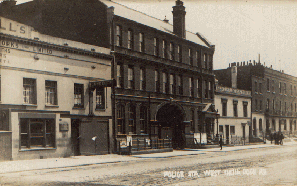 |
| Limehouse Police Station |
Then out with the Inspector to Pennyfields. No gambling after 8 o'clock he said, usually not later than 7. We entered two Chinese restaurants (11 p.m.) where lots of people were drinking tea. Humble people. All very clean and tidy indeed, and the people looked decent. A few nice-looking prostitutes - chiefly Jewesses. Nearly all houses closed. Some windows, said the Chief Inspector, were always shuttered. "They don't like the light". Glimpses of curtained bedrooms higher up. We went into a Chinese Music Club, where four men were playing Mah Jong and one strumming a sort of Chinese guitar, with very large string-pegs. Their singing nights were Wednesday and Saturday. A suggestion that they should sing was not well received. They were very polite but didn't want us. We were to have seen the Chinese Chapel, where the religion of Confucius is practised; but it was locked up.

Then we went into a pub (closed) and found one or two old topers (friends of proprietor's) drinking stout after hours. We were taken upstairs and there saw a wonderful collection of Chinese carving of all sorts - chiefly picked up from sailors. lastly, return to Police Station. No prisoners. Cells marvellously clean and sanitary. Steam heating. Temp. must be 63 at least. Plank bed, white as a yachts forecastle, but a pretty comfortable pillow; one rug. On the whole a rather flat night. Still we saw the facts. We saw no vice whatever. Inspector gave the Chinese an exceedingly good character.
Has any district of London attracted as much attention as did Limehouse between the Great War and the 1930s? Limehouse, and its ghostly double ‘Chinatown’, figured as a dangerous and exotic place in a whole series of novels, films, magazines, even in popular songs. Public responses to several drug scandals, to interracial marriage, to housing shortages and unemployment, contributed to an enduring myth: the idea of a Chinatown in Limehouse that never really existed. Before the First World War there were never more than a few hundred Chinese people in London - and many of these were transitory sailors.
We dropped anchor in the Candia roadstead about 8.30 a.m. Knossos is the magnet that draws the inquisitive tourist to Candia. You drive two or three short miles, past Venetian fortifications and past vineyards, under a most fervent sun, and are immediately moved backwards several thousand years. The excavations and reconstructions have evidently been carried out with the greatest skill, judgement and imagination. Their achievement is to make you see and feel what at any rate the latest palace actually was.


No comments:
Post a Comment